|
Wisley's Alpine Log
By Paul Cumbleton
Log 23 6th November 2008
A rather different kind of log this week. Not many pictures but do read the text - I think you'll find it fascinating.
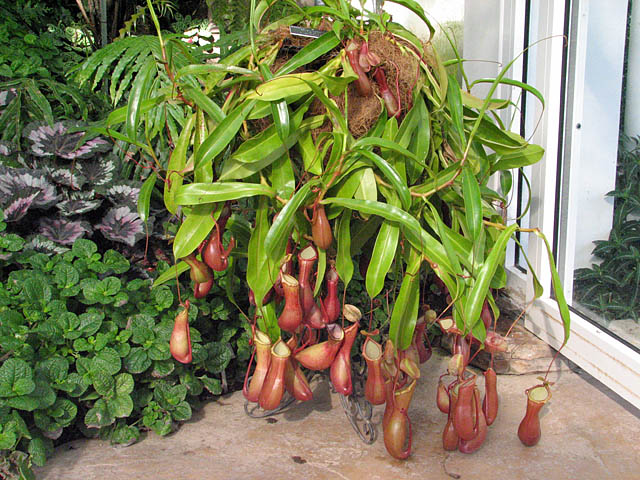
Nepenthes alata x ventricosa
The carnivorous pitcher plants (Nepenthes species) such as the one shown above are not exactly alpines but I recently read something newly discovered about them that I just had to share with you because it is so interesting. These traps (pitchers) vary greatly from species to species in terms of size and colour. Here are just a couple of examples:
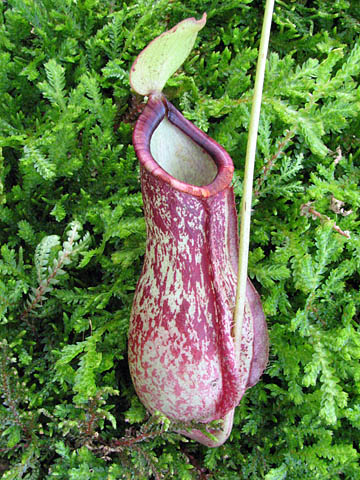
Pitcher 1
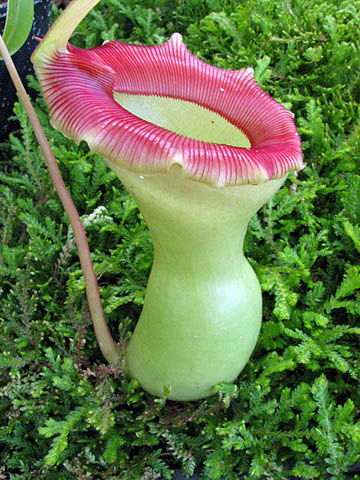
Pitcher 2
Amongst carnivorous plants, pitchers had been thought to be some of the simplest in terms of how they catch things - their prey just falls in. But recently our view of them as simple traps has all changed. Previously it was believed that there was just one simple mechanism explaining why their prey falls into the traps. The pitchers - which are actually modified leaves - form a simple container in which is a fluid. The mouth of the pitcher has a pronounced rim that bends back round the top edge. If we look again at one of the pictures above I have labelled these parts:
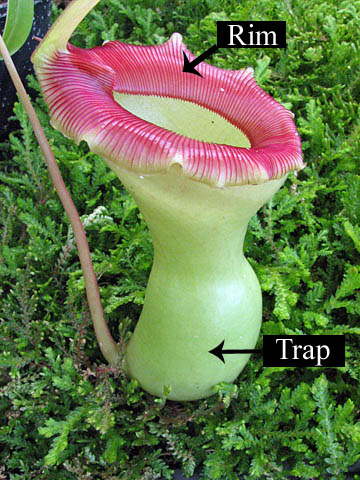
Pitcher parts
Just beneath this rim, on the inside, are glands that produce the nectar that attracts prey. Beneath the glands, there is a zone where the inner wall of the pitcher is smooth and covered in wax. The wax is comprised of small, loosely attached crystals. Insects are normally very good at being able to maintain their grip even on very smooth surfaces, but when they walk on the pitcher's wax, the wax crystals slough off and fall - with the prey - into the fluid below. The same waxy area prevents them being able to climb out again.
Pitcher plants have been studied for years and everyone thought that was that. However, almost all the work had been done on plants in cultivation or on herbarium specimens. New observations from plants in the wild have revealed that pitcher plants are far more cunning than at first it seems. Suspicions that there must be more going on were aroused when it was noticed that insects often fall straight off the rim into the trap without ever touching the waxy layer. Also, some species of Nepenthes lack a waxy layer altogether, while others produce some pitchers with and some without such a layer. These species still manage to catch insects perfectly well. Observations in the wild showed that the rim of the pitcher was important. When it was dry, insects could walk on it perfectly well - but when it was wet after rain they slid off it into the trap. The researches knew this was unusual - most plant surfaces repel water, whereas the pitcher rims seemed unusually wet. They concluded it must have an interesting stru
cture. When a dry rim had water dropped onto it, it rapidly spread out over the surface. Investigations showed that this spreading was enhanced by the outer tissue being covered in microscopically small ridges. The thin film of water prevented insects getting a grip and they slid off into the trap. The number of insects caught when the rim was wet was three times the number caught when it was dry, suggesting this and not the waxy layer below is actually the main trapping mechanism.
There was plenty more to discover. Further observations showed that the rim became wet at times even when it had not been raining. Constant monitoring revealed a daily cycle - they were dry for much of the day and caught little, but became wet from early evening to morning and caught a lot more. It was found that the nectar the pitchers produced was hygroscopic - this means it can absorb moisture from the air. Thus thinned, it then spreads out over the rim. This is a new function for nectar not observed yet in other plants. It is possible that the plants can adjust how wet their lips become by adjusting the amount of nectar they produce. Exactly when a trap's rim is wet and when it is dry is unpredictable - it varies with the nectar production, the time of day, the weather and where exactly it grows. This unpredictability can be an advantage - it makes it hard for prey to evolve any defence. It may also increase the numbers of insects caught. For example, hungry ants may send out scouts to locate food sources
. If a single scout happens on a pitcher that has a wet rim it will of course fall in. But if it encounters a dry rim it will survive and it may go back to tell the colony it has located a food supply. Lots of them may then follow it back to the plant. If meanwhile the rim has become wet, a large number of ants will be caught. Cunning eh?
Another newly discovered fact concerns the fluid inside the pitcher. You can see the fluid in this photo:
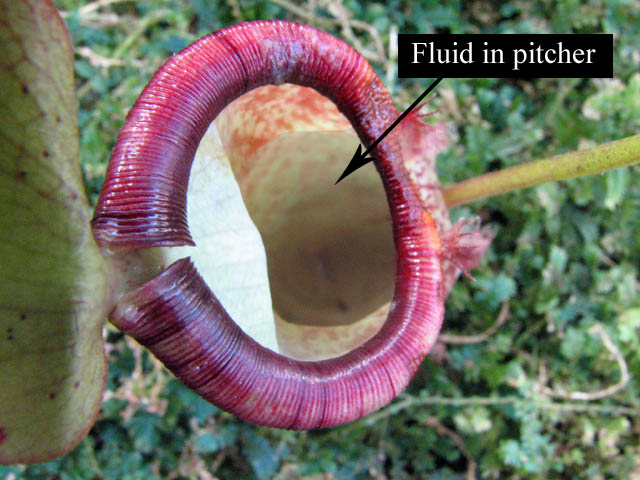
Fluid in pitcher
It is not just water. If a fly is dropped into water it can usually rapidly escape and fly away. But insects seem unable to escape from pitcher fluid. Observations and analysis showed this had nothing to do with surface tension or with any rapid kind of chemical attack. They also showed that only MOVING insects became wetted and drowned. Analysis showed that the fluid is what is called "viscoelastic". Movement within the fluid causes it to become stretchy and stringy. An insect's panicky movements cause the fluid to thicken so it is hard to swim. If it tries to lift a leg out of the fluid, it forms an elastic strand that is hard to break and pulls the leg back into the fluid. The faster the insect moves, the greater this effect. The only way it could escape would be to move more slowly, but they usually panic and thrash about. So, pitchers are far from a passive trap - they have sophisticated mechanisms for both catching prey and keeping them trapped once caught. You can read the full account, by Stephanie Pa
in, in New Scientist magazine, 7 June 2008, pages 34 - 37.
^ back to the top ^
|

